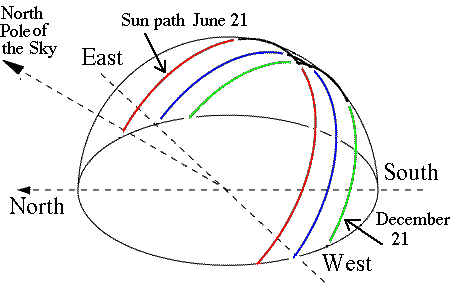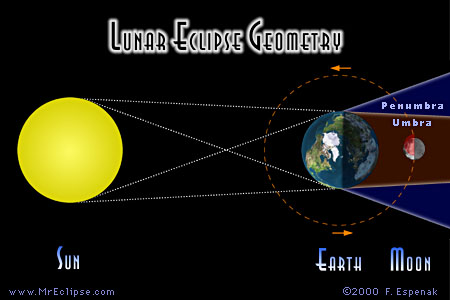The December solstice, shortest day of the year is tomorrow, December 21. At approximately 7:38 p.m. EST (2338 UTC), the Sun’s apparent motion in the sky will come to a standstill (Latin, solstitium).* That’s because it has finished its southward migration for the year, and from here until June old Sol will travel north. And as it does so, days in the northern hemisphere will get longer. The image below, from an excellent NASA website, shows the paths of the sun on the longest and shortest days of the year:

However, the solstice is an event that, while observable on relatively long time scales, is not so interesting to the observer at any given moment. But early tomorrow morning there will be a much more immediately observable event: a total lunar eclipse. The moon is scheduled to be entirely within the earth’s shadow (see image below) between 2:41 and 3:53 a.m. EST: a full 72 minutes of muted glory!

During totality, the southern half of the moon will be much darker than the northern half, as Fred Espenak explains:
From the eclipse diagrams shown earlier, it is clear that the southern (bottom) edge of the Moon will dip much deeper into the Earth’s shadow than will the northern (top) edge. Since Earth’s umbral shadow is darker in the center than at the edge, the Moon’s appearance will likely change dramatically with time as the total phase progresses. A large variation in shadow brightness can be expected and observers are encouraged to estimate the Danjon value at different times during totality (Danjon Brightness Scale). Note that it may also be necessary to assign different Danjon values to different portions of the Moon at different times.
This could be an excellent opportunity for budding astronomers and students to test their observing skills. Try recording your estimates of the Moon’s brightness every ten minutes during totality using the Danjon Scale. Compare your results with your companions and classmates and discover how the Moon’s appearance changes during the total eclipse. The brightness of the totally eclipsed Moon is very sensitive to the presence of volcanic dust in Earth’s atmosphere. As part of a continuing research project, Dr. Richard Keen has been using reports of lunar eclipse brightnesses to calculate a history of optical thicknesses of volcanic dust layers (see: What Will 2004’s Lunar Eclipses Look Like?). If you’d like to help Dr. Keen by making eclipse observations, you can contact him at Richard.Keen@colorado.edu.
Now, as you probably know, lunar eclipses only occur during a full moon. So at midtotality, 3:13 a.m., the last full moon of the year will occur, only 16 hours or so before the official moment of the solstice. When will there be another lunar eclipse during the December solstice? I have no idea.
But to show you how rare even the possibility of such an event is, the next full moon scheduled within 24 hours of the December solstice will take place in 2094. (The last one occurred in 1991.) I read somewhere online that there were only 7 full moons on the December solstice between 1900 and 1999, but I haven’t fact-checked that claim. And I should, because that actually seems like a pretty strong correlation, when you consider that there “should” be only 1 full moon on the solstice every 29.5 years, given that the moon takes 29.5 days to go from full to full. Either the claim is wrong, or my understanding of math is wrong, or both are wrong.
[UPDATE: For an AMAZING pictorial explanation of the event, check out today’s Astronomy Picture of the Day from NASA. The text there answers my speculation above: 456 years since the last solstice eclipse, but no idea when the next will be.]

